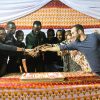The trauma and devastation of the Rwandan genocide in 1994 are almost beyond comprehension. Over a 100-day period, more than 800,000 people were killed, most of them members of the ethnic Tutsi minority.
In her May 31 talk, “My ‘Senior’ Semesters Abroad at Agahozo-Shalom Youth Village,” faculty associate Phyllis Lerner introduced two additional facts of special significance for educators. First, the genocide and resulting civil upheaval left behind an estimated 400,000 orphans. Second, approximately 60 percent of Rwanda’s teachers disappeared, either killed or forced to flee the country.

Phyllis Lerner, far right, took part in ASYV’s New Year’s celebration.
Amid a critical shortage of trained educators, a generation of children was suddenly at risk. Out of this continuing crisis, a new educational approach has emerged in the success of the Agahozo-Shalom Youth Village (ASYV). Lerner, who has now spent two spring semesters at ASYV, believes this residential learning community in rural Rwanda “may well be the most effective global model for orphaned and displaced youth, especially in post-conflict areas.”
ASYV founder Anne Heyman heard of Rwanda’s orphan crisis in 2004 and was reminded of a similar challenge faced by Israel in responding to a large influx of orphans from the Holocaust. Rather than build traditional orphanages, the nation developed special residential learning communities where children who had suffered severe trauma and loss of family connections could heal in a humane, nurturing environment: a youth village. Inspired to adapt this model to the unique circumstances and social fabric of Rwanda, Heyman engaged Rwandan community leaders and neighbors, as well as global education and public health experts, to create a 144-acre planned community that welcomed its first cohort of students in 2007.
Now in its 10th year, the village focuses on developing students both cognitively and socially. Its high school follows the Rwandan National Curriculum, but uses a mediated, child-centered method to deepen understanding. The ASYV model combines four essential elements for the intellectual and emotional growth of its 500 students: family support, educational structure, health care and extracurricular engagement.

The Agahozo-Shalom Community Center
For Lerner, serving as a mentor and “auntie” to these youth has been a transformative opportunity. After a 40-plus-year career in education and educational equity—including serving as a faculty associate in the School of Education’s Teach for America partner program since 2009—the experience marked an inspirational return to her early passion for promoting global education.
She also sees ASYV as an excellent opportunity for early-career educators. ASYV’s Fellows Program annually places eight to 10 international volunteers in the village, where they serve in professional roles and work together with Rwandan staff to support and develop programs. Each fellow plays an integral role in community life, joining a student family and serving as a mentor (“cousin”) to 16 to 24 first-year students.
For more information on the Agahozo-Shalom Youth Village, visit www.asyv.org.

